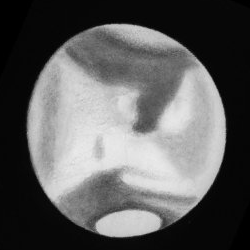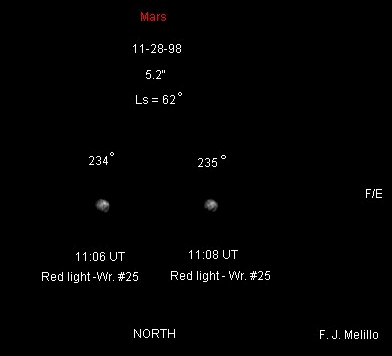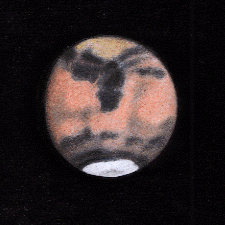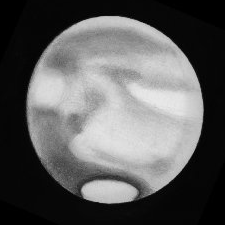98/99 report #03
1998/99 Mars Observation Reports -- #03--
OAA MARS SECTION - Monthly Report published in CMO No
210 (25 December 1998)
Martian Sufaces Observed from 16 November to 15 December 1998
- - - by Masatsugu MINAMI, Director of the OAA Mars Section ---
THIS TIME:
We treat principally the observations made during the one-month period
from 16 November 1998 to 15 December 1998.
The Martian season proceeded from 058°Ls to 070°Ls; the north polar cap (npc) being on the way of thawing. The central latitude was from 25°N to 24°N. The apparent diameter augmented from 4.9" to 5.6". The phase angle increased from 31° to 34°.
The apparent declination of Mars crossed the celestial equator down to south at the beginning of December. The planet is well high up near the meridian at dawn (the western quadrature will occur on 11 January 1999), but already the altitude is unsatisfactory. The Sun now rises after 7 o'clock (22h GMT) at present (around Winter Solstice) at Fukui.
NEWS:
GRAY (DGr) at Kirk Merrington started his routine observations of Mars in October, and as far as we received, his first observing sheet records the planet on 19 Oct (045°Ls) when the apparent diameter was 4.4". DGr's pencil drawings are very beautiful keeping to the British traditions. The letters on the sheets are also impressively laid out.
ISHADOH (Id) prepared since the beginning of November, and made his first observation on 28 Nov (063°Ls) when App.Diam. δ=5.2".
MELILLO (FMl) also began to take some CCD images since 28 Nov: The images are small but show some details. On 15 Dec,
WHITBY (SWh) took his first drawing of this season at 11:20GMT.
OBSERVATIONS:
The following include the observations made during the present period.
GRAY, David (DGr) Durham, UK
8 Drawings (19, 22, 23, 31 October; 6, 17, 23 November; 2 December 1998)
415, 520, 660× 42cm Dall-Kirkham
HIKI, Toshiaki (Hk) Minowa, Nagano, Japan
10 Drawings (23, 29, 30 November; 5, 9, 11, 12 December 1998)
340, 360× 16cm speculum
ISHADOH, Hiroshi (Id) Naha, Okinawa, Japan
4 Drawings (28 November; 1, 12 December 1998) 530, 800× 31cm speculum
MELILLO, Frank J (FMl) NY, USA
2 CCD Images (28 November; 12 December 1998) 20cm Schmidt-Cassegrain
MINAMI, Masatsugu (Mn) Fukui, Japan
50 Drawings (23, 25, 26, 28, 29 November; 2, 3, 13, 15 December 1998)
400× 20cm refractor*
MURAKAMI, Masami (Mk) Yokohama, Japan
10 Drawings (23 November; 9, 11, 12, 13 December 1998) 370× 15cm speculum
NAKAJIMA, Takashi (Nj) Fukui, Japan
21 Drawings (23, 25, 26, 28, 29 November; 2, 3, 13, 15 December 1998)
400× 20cm refractor*
WHITBY, Samuel R (SWh) VA, USA
1 Drawing (15 December 1998) 310× 15cm speculum
* Fukui City Observatory
NB:
We were happy to receive the drawings by NBr (reported in #208), just after finishing the edition of #209. He obtained a detailed image by 1010x on 24 Oct (see below).
BIVER, Nicolas (NBv) Hawaii, USA
4 Colour Drawings (20, 26 September; 23, 24 October 1998)
510, 1010× 26cm speculum
 REPORT: DAY BY DAY
REPORT: DAY BY DAY
The morning the Leonids sparkled on 17 Nov (058°Ls), David GARY (DGr) was at the eyepiece to observe the red planet whose surface showed Syrtis Mj near the CM at ω=277°W (6:40GMT) - 282°W. Seeing was so good through high thin cloud that N Alcyonius was definitely seen though fleeting. Protonilus was isolated from the dark band around the npc. Hellas was well seen but dull in Wr25. Aeria was light through Wr58. App. Diam. δ= 4.9". At least at Fukui the sky on the night of 17 Nov was bad, and in fact the weather was dismal for several days the week and we all again missed to observe the area of Solis L.
Drawing by David GRAY on 17 Nov (058 ° Ls) at ω=277 ° W
One week later on 23 Nov (061°Ls) we re-started: Mk observed at ω=058°W, Hk did at ω=065°W. Both watched the evening M Acidalium; and in contrast the npc was clear bright. Hk caught Lunae L. Chryse looked dull to him. On the night at Fukui, Mn and Nj started from ω=034°W and chased until ω=078°W (at 21:40GMT). M Acidalium looked slightly dark brownish, while the area of Aurorae S dark bluish. From around ω=050°W, Chryse was distinctly whitish misty and apparent upto the end of the final session. The southern limb was whitish hazy especially at the morning side. On the day, about 14 hours earlier (more eastern by about 200°) than us, DGr observed the surface of ω=233°W (at 07:40GMT): Syrtis Mj was at the morning side, and its west was limb-hazed. Utopia was rather weak while M Acidalium darker in the morning. Elysium was dimly seen at the evening side. The npc was bright though all filters.
25 Nov (062°Ls) at Fukui, Mn noticed that Noachis was whitish near the evening terminator at ω=036°W.
26 Nov (063°Ls) seeing was poor at Fukui, but improved in the twilight, and the evening Chryse looked whitish light as well as the southern limb.
 28 Nov (063°Ls), MELILLO (FMl) obtained red-light CCD images at ω=234°W. The images are small, but show the Aetheria dark patch. Furthermore the triangular shape of Utopia is apparent in one of two images. The dark markings at the SH is also shot. On the day (28 Nov) at Fukui we started from ω=330°W when Hellas was white, while at ω=340°W it did not show up. M Acidalium came dark. At ω=350°W, Sabaeus S looked dark at the evening side. The npc quite roundish. Chryse now light at the morning limb in off-white. At ω=010°W, Noachis or its north looked very bright. ISHADOH (Id) made his first observation on the day at ω=017°W: M Acidalium is not so apparent, the southern limb dimly light. At Fukui we observed up to ω=034°W (by Nj) in the twilight. The sky was fine after midnight and we could watch Canopus alpha-Car to slowly move low in the southern sky before the Mars sessions, but later the City below was totally covered by a dense morning fog. It was reported the lowest temperature recorded was 2.2degreesC at Fukui.
28 Nov (063°Ls), MELILLO (FMl) obtained red-light CCD images at ω=234°W. The images are small, but show the Aetheria dark patch. Furthermore the triangular shape of Utopia is apparent in one of two images. The dark markings at the SH is also shot. On the day (28 Nov) at Fukui we started from ω=330°W when Hellas was white, while at ω=340°W it did not show up. M Acidalium came dark. At ω=350°W, Sabaeus S looked dark at the evening side. The npc quite roundish. Chryse now light at the morning limb in off-white. At ω=010°W, Noachis or its north looked very bright. ISHADOH (Id) made his first observation on the day at ω=017°W: M Acidalium is not so apparent, the southern limb dimly light. At Fukui we observed up to ω=034°W (by Nj) in the twilight. The sky was fine after midnight and we could watch Canopus alpha-Car to slowly move low in the southern sky before the Mars sessions, but later the City below was totally covered by a dense morning fog. It was reported the lowest temperature recorded was 2.2degreesC at Fukui.
CCD image by MELILLO on 28 Nov (063 ° Ls) at ω=234 ° W
29 Nov (064°Ls), Hk observed at ω=010°W. At Fukui we started from ω=321°W under poor seeing: Syrtis Mj was obscure. From around ω=350°W, S Sabaeus was dark evident at the afternoon side, but M Acidalium was the darkest. Later M Erythraeum was appeared dark. Watched until ω=019°W (twilight).
30 Nov (064°Ls), Hk watched at ω=000°W (21:00GMT): the npc white evident. The dark fringe was darker at the evening side. S Sabaeus rather easily caught (unexpectedly to Hk).
As December came in, on 1 Dec (064°Ls), Id observed at ω=348°W (App.Diam. δ=5.2"): S Meridiani was obscure, while M Acidalium was quite dark under improved seeing. Chryse light.
2 Dec (065°Ls), DGr at Kirk Merrington observed at ω=149°W. The npc had become slightly shrunk and not so bright as before. The area near the evening terminator looked light though it was not easy to discern Olympus Mons clearly. The southern limb light. Ten and a few hours later, we watched at Fukui the area of S Sabaeus to be dark at its eastern part e.g. at ω=336°W.
3 Dec (065°Ls) we started from ω=290°W: Naturally Syrtis Mj was definite. M Tyrrhenum and Utopia dark. The dark band around the npc including Utopia looked darker than Syrtis Mj. Mn observed at ω=300°W that Hellas was duller (phase angle = 33°), while Nj observed at ω=304°W that Hellas blue-whitish light. Hellas became eventually bright near the evening terminator. The sky was fine but the city below was thickly veiled by a foggy stream.
5 Dec (066°Ls) Hk observed at ω=296°W, 305°W and 313°W: Syrtis Mj was caught easily especially after the planet high up at dawn. Hellas was not light and dim. Hk saw S Sabaeus as well as the following S Meridiani, but the latter was difficult to be discerned from the morning dark limb patches. Anyway Hk enjoyed the best-seeing opportunity so far in this apparition. On the day (Saturday), Nj was at Kyoto, and Mn at Otsu, and also Mk visited Otsu, and so nobody of the three could observe the night. On Sunday the three had a meeting at Otsu. Nj soon returned home, but he was not provided by good weather next week at Fukui.
9 Dec (068°Ls) Mk observed at ω=258°W, and Hk at ω=265°W. It was difficult for Mk to catch Syrtis Mj, but the time when Hk watched, Syrtis Mj came faintly. M Tyrrhenum was darker. Hk thought of a presence of a morning mist following Libya.
11 Dec (069°Ls) Mk observed at ω=231°W, 244°W, and 251°W while Hk at ω=246°W and 259°W. Mk felt a blue-whitish light to the south of the dark markings at the SH. Hk caught Syrtis Mj at ω=259°W. The npc clear and roundish. Mk notes that a waning moon was near the red planet on the night.
12 Dec (069°Ls), Mk observed at ω=236°W, 246°W and 256°W, Hk at ω=239°W and Id at ω=249°W and 259°W: Mk checked the lightness of the southern limb. Hk watched Syrtis Mj while Mk noted the morning mist over Aeria. Id saw weakly Syrtis Mj at first but at the second time detected it dark together with M Tyrrhenum. Aeria light. Elysium undetected. Hellas was only dimly light. On the same day (12 Dec), Mn returned from Otsu and harried to the Observatory. Nj was absent, and Mn watched alone from ω=190°W to 258°W every forty minutes. The haze at the southern limb was evident. Syrtis Mj was visible from ω=239°W as was the case of Hk, but it appeared more conspicuous as the planet became high up. In particular its south was darker, and Aeria was bright as if protruding. M Cimmerium also quite dark at the evening side. The npc looked definitely normal, apparently smaller than before. The position of the eyepiece had moved more to northward, implying the planet was already lower in the sky. Much earlier on the day, FMl at NY secured CCD images at ω=100°W: M Acidalium is present, and Aurorae S is also dark. Maybe also Nilokeras-Ganges is visible. No npc because they are through Wr25.
13 Dec (070°Ls) Mk observed at ω=241°W and felt a lightness at the southern and morning limb. On 13 and 15 Dec, Nj and Mn joined, but it was rather cloudy and results few. Just M Cimmerium was dark checked on 15 Dec.
Finally on 15 Dec, WHITBY (SWh) produced a drawing at ω=073°W, where M Acidalium was dark near the terminator. Chryse light in the evening as well as Tharsis at the morning side. The npc was quite delineated without hood.
WE FURTHER RECEIVED:
As reported in #208, BIVER (NBv) made his first observation on 20 Sept (032°Ls) when App. Diam. δ=4.1". The surface showed ω=254°W (at 15:40GMT) when Syrtis Mj appeared obscurely at the morning side. Utopia was definite. The morning-limb side of the NH is whitish hazy.
The second drawing was made on 26 Sept (035°Ls) at ω=198°W where Propontis I was not so apparent but the morning limb was heavily veiled by several patches of mists.
The third on 23 Oct (067°Ls) at ω=277°W where Syrtis Mj was definite near the CM, and Hellas looked off-white (more yellowish at the afternoon side) with an irregular boundary.
The fourth on 24 Oct (048°Ls) at ω=290°W which was obtained in good seeing: the dark markings including Syrtis Mj being detailed. We see a fine rift segment inside the npc (see the drawing here).


Left : Drawing by BIVER on 24 Oct (047 ° Ls) at ω=290 ° W
Right : Drawing by GRAY on 31 Oct (050 ° Ls) at ω=080 ° W
GRAY's drawings made before 15 Nov are as follows as far as we received:
19 Oct (045°Ls), DGr observed at ω=188°W. The apparent diameter was only 4.4", but he detected a light belt in Cebrenia which separated the area around Propontis I and the dark band of the npc. The dark fringe of the npc was very conspicuous. Elysium was not particularly light but discerned. The dark markings at the SH were weak, and the southern limb was rather bright at the morning side.
22 Oct (046°Ls) at ω=168°W, two bright patches were visible near the evening terminator. A shadowy band near Propontis I. Elysium limbed by shadowy bands coming.
23 Oct (047°Ls) at ω=153°W, DGr detected the faint Olympus Mons, visible through all filters (phase angle ι=28°). Used an apodising screen. Tharsis looked diffused. Elysium pretty light in the morning. Notable that out of the dark band of the npc the area at Propontis II was well defined and darker.
31 Oct (050°Ls) at ω=080°W (at 6:30GMT), DGr met good views where M Acidalium lay near the evening terminator letting Nilokeras protrude. Deuteronilus was separated. Xanthe was light near the evening terminator. The afternoon side of the southern limb was bright in Wr58. Notable is the cloud belt running from Tithonius L to the morning limb, striking in Wr15 and diffused in Wr58 (see the drawing cited here)). This cloud belt was located at the Tharsis region and well reminiscent of the white mist patches seen frequently in later season at around 100°Ls in 1997. This must possibly be said to be a nice detection of a sign of a start of the Equatorial Band Mist.
6 Nov (053°Ls) at ω=022°W, DGr obtained a good view of the surface where M Acidalium was near the CM which was quite detailed. S Sabaeus still remained, and Margaritifer S was very evident. Chryse fairly light. The southern limb was light in Int and Wr15 and its evening was brighter in Wr58. It should be remarked that some of DGr's drawings are accompanied by other sketches taken ten or twenty minutes later, and hence a total number of drawings we received are more than our count.
ON LEONIDS:
On the day of 17th Nov an enhanced activity of Leonid was expected: GRAY (DGr) felt during the session of the drawing cited before a distraction at the eyepiece when a Leonid fireball sparkled which must have been equal to several Full Moon's luminosity. It flashed and illuminated his surroundings, at 6:28GMT. As to the activity of the Leonids at Kirk Merrington before observing the planet, see LtE. On the night of 17 Nov at Fukui we (Nj and Mn) were at the Observatory, but could not observe Mars nor watch the meteors. We had a moment of the clear sky but no shooting stars, and hence we concluded that any Leonid storm did not come over the oriental area. HIKI (Hk) and MURAKAMI (Mk) were at other places than the Mars observing stations and saw several bright Leonid meteors and trains (Hk took a big one by the use of G800 - click here).
Reports will be acknowledged if air-mailed to M MINAMI at Mikuni
(ask the mail-address through vzv03210@nifty.ne.jp ) .
Back to Top Page
 REPORT: DAY BY DAY
REPORT: DAY BY DAY 28 Nov (063°Ls), MELILLO (FMl) obtained red-light CCD images at ω=234°W. The images are small, but show the Aetheria dark patch. Furthermore the triangular shape of Utopia is apparent in one of two images. The dark markings at the SH is also shot. On the day (28 Nov) at Fukui we started from ω=330°W when Hellas was white, while at ω=340°W it did not show up. M Acidalium came dark. At ω=350°W, Sabaeus S looked dark at the evening side. The npc quite roundish. Chryse now light at the morning limb in off-white. At ω=010°W, Noachis or its north looked very bright. ISHADOH (Id) made his first observation on the day at ω=017°W: M Acidalium is not so apparent, the southern limb dimly light. At Fukui we observed up to ω=034°W (by Nj) in the twilight. The sky was fine after midnight and we could watch Canopus alpha-Car to slowly move low in the southern sky before the Mars sessions, but later the City below was totally covered by a dense morning fog. It was reported the lowest temperature recorded was 2.2degreesC at Fukui.
28 Nov (063°Ls), MELILLO (FMl) obtained red-light CCD images at ω=234°W. The images are small, but show the Aetheria dark patch. Furthermore the triangular shape of Utopia is apparent in one of two images. The dark markings at the SH is also shot. On the day (28 Nov) at Fukui we started from ω=330°W when Hellas was white, while at ω=340°W it did not show up. M Acidalium came dark. At ω=350°W, Sabaeus S looked dark at the evening side. The npc quite roundish. Chryse now light at the morning limb in off-white. At ω=010°W, Noachis or its north looked very bright. ISHADOH (Id) made his first observation on the day at ω=017°W: M Acidalium is not so apparent, the southern limb dimly light. At Fukui we observed up to ω=034°W (by Nj) in the twilight. The sky was fine after midnight and we could watch Canopus alpha-Car to slowly move low in the southern sky before the Mars sessions, but later the City below was totally covered by a dense morning fog. It was reported the lowest temperature recorded was 2.2degreesC at Fukui. 
